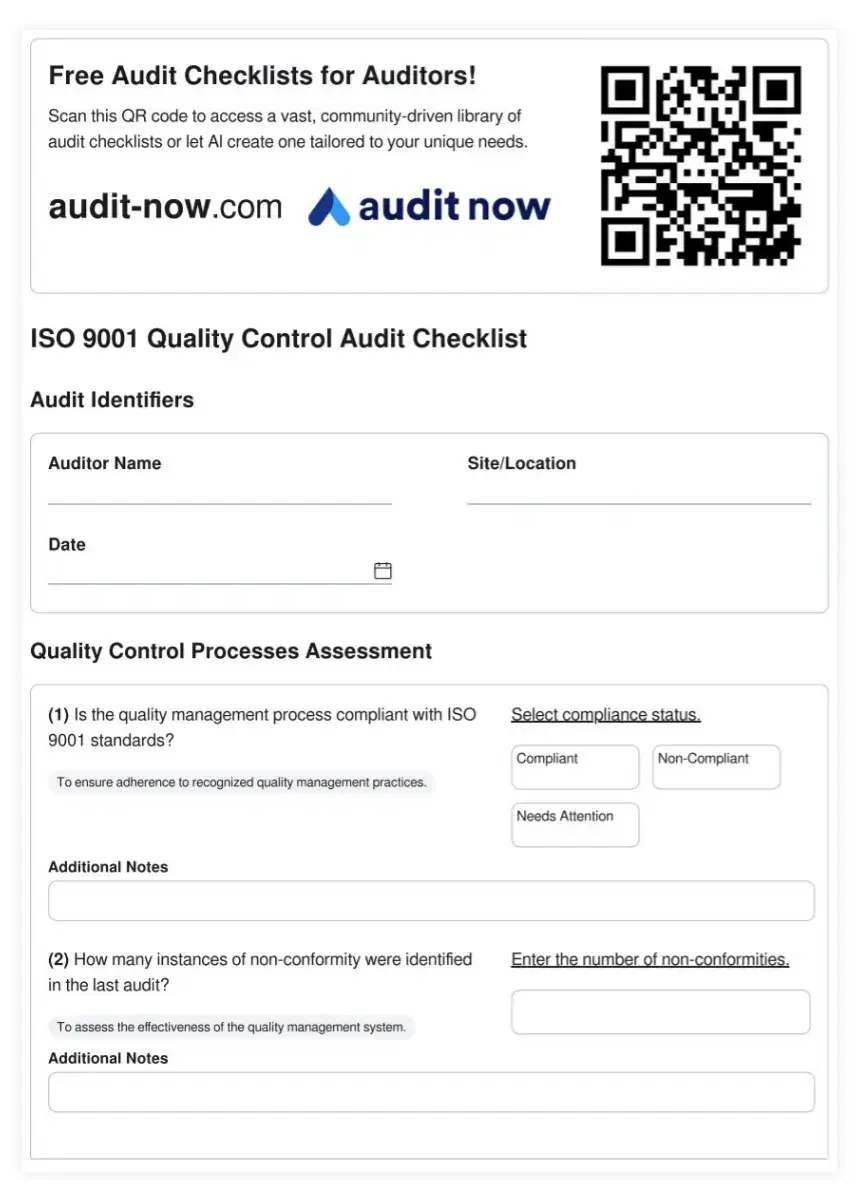Facility Managers Checklists

Featured Checklist

JCI Facility Management and Safety Audit Checklist
The JCI Facility Management and Safety Audit Checklist is a vital tool for healthcare organizations aiming to comply with Joint Commission International (JCI) standards and ensure a safe, functional, and supportive care environment. This comprehensive checklist addresses critical aspects of facility management, safety systems, and emergency preparedness, helping healthcare providers identify potential hazards, maintain regulatory compliance, and optimize the physical environment for patient care. By systematically evaluating facility-related risks and safety measures, this checklist empowers healthcare professionals to create a secure and efficient healthcare setting, minimize accidents, and enhance overall operational effectiveness.
Facility managers face a complex web of responsibilities. They must keep buildings running smoothly, ensure safety, and manage resources wisely. Balancing these tasks can be tricky. One missed detail can lead to big problems.
Good facility management directly impacts a business. It affects worker comfort, energy use, and even company image. When things work well, people notice. When they don't, it can hurt the bottom line. That's why quality management is so important in this field.
To handle these challenges, facility managers need a solid system. This is where auditing comes in. Let's look at why audits are crucial for success.
Core Audit Requirements & Checklist Importance
Audits are key tools for facility managers. They help spot issues before they become big problems. A good audit covers all areas of facility operations. This includes safety checks, equipment maintenance, and compliance with rules.
Checklists play a big role in audits. They ensure nothing is missed. A well-made checklist guides managers through each step. It helps create a standard way of doing things. This leads to better results and fewer mistakes.
Following rules is a must in facility management. There are many laws about building safety and operations. Regular audits help make sure these rules are followed. This protects the company from fines and legal trouble.
- Safety protocols: Check fire systems, emergency exits, and first aid kits
- Equipment maintenance: Inspect HVAC, elevators, and electrical systems
- Energy efficiency: Review lighting, insulation, and power usage
- Cleanliness standards: Assess cleaning procedures and waste management
- Security measures: Evaluate access control and surveillance systems
Say Goodbye to Generic Audits
No More Generic Audits – Customize AI Checklists for Your Facility
Generate AI Checklist
Navigating Facility-Specific Challenges
Each type of facility has its own set of challenges. For example, managing a hospital requires strict hygiene controls. An office building might focus more on creating a productive workspace. Industrial facilities often deal with heavy machinery and safety risks.
Best practices vary by facility type. In healthcare, regular sanitization is key. For offices, ergonomic furniture and good lighting matter. Factories need robust safety gear and clear emergency procedures. Knowing these specifics helps create better audit checklists.
Quality control in facilities management means different things in different places. A school might prioritize indoor air quality. A data center would focus on temperature control and power backup. Tailoring quality measures to the facility type is crucial for success.
Optimizing Facility Management Processes
Improving processes is an ongoing task for facility managers. This might mean finding better ways to schedule maintenance. Or it could involve streamlining how work orders are handled. The goal is to do more with less, without cutting corners on quality or safety.
Risk management is a big part of the job. This includes preparing for events like power outages or natural disasters. It also means looking at daily risks like slip hazards or equipment failures. Good risk management keeps people safe and protects the facility.
Measuring performance helps facility managers know what's working. Key metrics might include energy use, maintenance response times, or occupant satisfaction. For example, tracking how quickly repairs are done can show if the maintenance team is effective. These numbers guide decisions and show where improvements are needed.
Digital Transformation with Audit Now
Modern facility management is going digital. AI-powered checklists are changing the game. They can learn from past audits to suggest improvements. They also adapt to your facility's unique needs. This means more thorough and efficient audits.
Real-time collaboration is another big advantage of digital tools. Team members can update checklists from anywhere. Managers can see progress instantly. This speeds up problem-solving and keeps everyone on the same page. Plus, a digital template library means you don't have to start from scratch. You can use proven checklists and customize them for your needs.
Ready to upgrade your facility management? Check out our template library at audit-now.com/templates/. Want a custom checklist? Try our AI checklist generator at audit-now.com/generate-ai-checklist/.